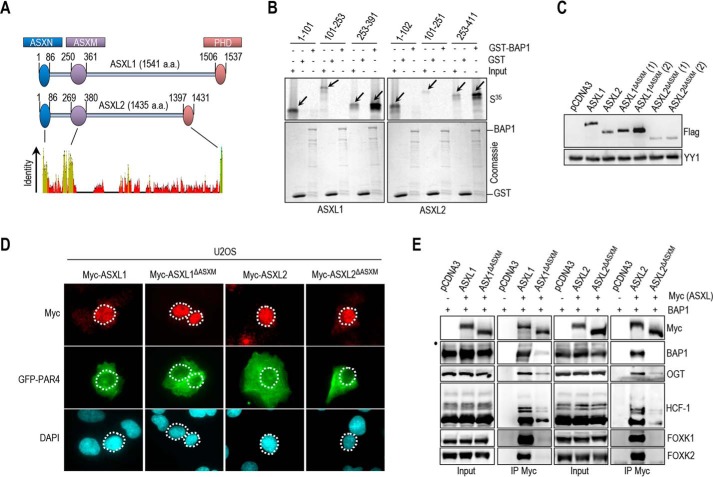FIGURE 3.
ASXM of ASXL1/2 is required for interaction with BAP1. A, schematic representation and conservation of ASXL1/2. B, GST pulldown assay using GST-BAP1 and methionine 35S-labeled ASXL1 or ASXL2 fragments. The arrows indicate the full-length forms of the fragments. C, ASXM is required for ASXL2, but not ASXL1, stability. FLAG-ASXL1/2 and their respective FLAG-ASXL1/2 ΔASXM mutants (3 μg each) were transfected in 293T cells which were harvested, 3 days post-transfection, for immunoblotting. A duplicate of transfection is shown for FLAG-ASXL1/2 ΔASXM mutants. D, U2OS cells were transfected with either Myc-ASXL1 (4 μg), Myc-ASXL1 ΔASXM (4 μg), Myc-ASXL2 (4 μg), or Myc-ASXL2 ΔASXM (4 μg) along with GFP-PAR4 (0.5 μg). Three days post-transfection, cells were harvested for immunostaining using the indicated antibodies. The cells overexpressing the different forms of ASXL1/2 were encircled. E, 293T cells were transfected with Myc-ASXL1 (4 μg), Myc-ASXL1 ΔASXM (4 μg), Myc-ASXL2 (4 μg), or Myc-ASXL2 ΔASXM (6 μg), along with BAP1 (1 μg) vectors and harvested, 3 days post-transfection, for IP with anti-Myc. The dot indicates a monoubiquitinated form of BAP1 (E) (31).

